| "[Sozin] started the tradition of hunting dragons for glory. They were the ultimate firebenders. And if you could conquer one, your firebending talents would become legendary and you'd earn the honorary title, Dragon. The last great dragon was conquered long before I was born, by my uncle." |
| — Zuko to Aang.[1] |
The dragon is the original practitioner of firebending, capable of breathing fire. The species demonstrated the true way of firebending to the Sun Warriors' civilization, a precursor to the modern day Fire Nation,[1] as well as to Wan, the first Avatar.[2] As such, dragons are highly respected by both the Sun Warriors and the Fire Nation.
History
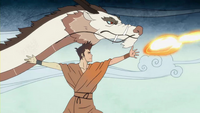
Wan learned the Dancing Dragon move directly from a dragon.
After Wan was banished from his village atop a fire lion turtle around 9,832 BG and, having been allowed to keep the power over fire from the creature, he began his life among the spirits in the Spirit Wilds. There, he came across a white dragon, who performed intricate movements while flying through the sky. Wan mimicked these movements and became the first known human to perform the Dancing Dragon.[2]
Millennia after Wan's encounter with a dragon, Aang and Kuzon searched Fire Nation mountaintops in the hopes of finding the elusive dragons a hundred years before Aang was frozen in the iceberg. They ended up saving a dragon egg from poachers and giving the egg back to its mother.[3]
During his time as Fire Lord, Sozin began the tradition throughout the Fire Nation of hunting dragons as the ultimate sport. Anyone who managed to slay a dragon earned the honorary title of "Dragon" and their talents as firebenders would become legendary. Near the end of the Hundred Year War, dragons were thought to be extinct due to General Iroh's claim that he had killed the final one. However, Aang and Zuko discovered that two dragons, Ran and Shaw, were still alive, deducing that Iroh had lied to protect the species.[1]
By 171 AG, a new dragon, Druk, had been born and came to be used by Zuko as a means of transportation.[4] However, dragons were still an extremely rare sight and very few people were still aware of their existence, as the average person was shocked to view one.[5]
Anatomy
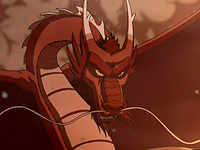
The dragon is a large, horned reptile with a long, scaly body that ends in a thin tail. It has four short legs and two large wings that enable it to fly quickly over great distances. There is also an instance of a green dragon which had an extra, smaller set of wings beneath its other wings.[3]
The dragon's head is large compared to the rest of its body, and its bearded face is dominated by a wide, flat nose and golden, cat-like eyes. There also seem to be several subspecies of dragons, as Ran and Shaw were much larger and had several physical features not present in the dragons owned by Roku and Fire Lord Sozin.[6]
Behavior
Dragons are intelligent creatures, capable of communicating with humans.[2] Although generally living in solitude, a dragon can form a tight bond with a human, even to the point where it will protect its human partner to the death.[6]
Notable dragons
- Druk
- Fang
- Green dragon
- Ran and Shaw
- Sozin's dragon
- White dragon
Red and blue dragons
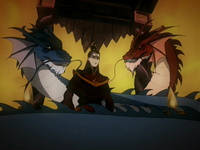
The red and blue dragons in Zuko's nightmare gave him advice.
The symbolism of the red and blue dragons has appeared several times throughout Team Avatar's adventures. Commonly, the red dragon represents honor and goodness, while the blue dragon represents seduction and evil.
While living in Ba Sing Se, Zuko dreamed that he was the Fire Lord and lacked his scar.[7] Two dragons, one red and one blue, gave him advice. The blue dragon spoke with the voice of Azula, Zuko's sister who wielded blue flames when firebending; the red dragon spoke in the voice of Iroh, Zuko's caring uncle, who wielded the normal red fire.[8] The blue dragon sought to harm Zuko, encouraging him to sleep forever, whereas the red dragon told him to escape. This dream was eventually brought to life, when Azula and Iroh gave Zuko different advice in the Crystal Catacombs of Ba Sing Se.[9] Zuko decided to fight by Azula's side, later regretting his decision.
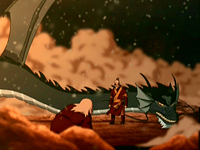
Sozin had a blue dragon.
The red and blue dragons also represented the conflict between Avatar Roku and Fire Lord Sozin, with Roku's dragon being red and Sozin's being blue. Roku and Sozin were initially friends, but they grew distant over time. Both dragons were present on Roku's island when Sozin betrayed Roku and left his old friend to die in the volcanic eruption - Sozin escaped on his blue dragon, while Fang swooped in so he could die with Roku.[6]
Of the original firebending masters, Ran and Shaw, one is a red dragon and one is a blue dragon. Though no distinction of personality or name was made between them, the red one paired with Zuko and the blue one with Aang as they do the "Dancing Dragon" form; however, when Aang and Zuko finished displaying the "Dancing Dragon" form and prepared to face the dragons' judgment, Aang faced the red dragon, and Zuko the blue one. The dragons deemed them worthy and showed Aang and Zuko the original meaning of firebending.[1]
Connection
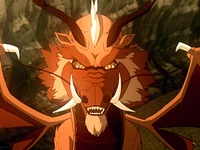
The head of a dragon showcases the typical Chinese influence.
Dragons in the World of Avatar are heavily influenced by the depiction of dragons in traditional Chinese culture. The long serpentine body, whiskers, fin-like ears, wild looking eyes, canine snout, and the position and proportions of the horns and legs suggest this particular oriental influence. However, other Asian cultural influences are present as, for example, the dragons in the series have four toes; this is a typically Korean trait. In Chinese and a significant proportion of Asian mythology, dragons are traditionally portrayed as a chimerical mix of lizards, camels, goats, and bats, among other animals; however, their image seems to have been refined in adaptation for animation and for the Western audience. The ability to breathe fire and the presence of wings are characteristics more common in European dragons, but they are included in the dragons of the Avatar universe as it is such an integral aspect of the western idea of dragons, and also for the fact that they are the primal benders for the art of firebending,[1] whereas oriental dragons were more closely associated with water.
Trivia
- In the non-canon comic "New Recruits", Hiroshi has a pet rock-dragon named Genji that complements his earthbending.
- Ran and Shaw encircle each other in a similar way to Tui and La. This symbolizes the taijitu, commonly known as the yin and yang symbol, which is usually black and white.
- There was a golden dragon statue in the Fire Nation's throne room during Sozin's reign.
- Dragons in the Avatar universe are a combination of both Chinese and European dragons. Chinese dragons are serpentine and have canine-esque snouts with whiskers, though they are more generally affiliated with water than any other element. One of the nine different types of Chinese dragons has wings, just as in the franchise. In addition, different colored dragons are associated with different locations, as blue dragons reside in bodies of water while red dragons are associated with the south. However, European dragons have wings and breathe fire, indicating that the dragons in Avatar are a combination of the two cultural "species types".
- Dragons are known to show affection by licking people, similar to real world domestic pets do.[3]
- While the dragons of the Avatar World are depicted with wings, the white dragon with which Wan trained during the Era of Raava did not possess any.[2]